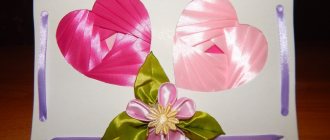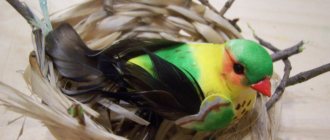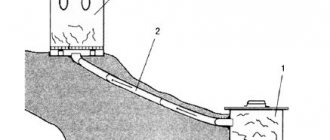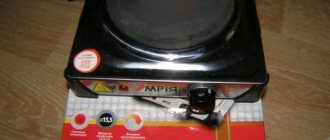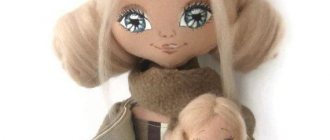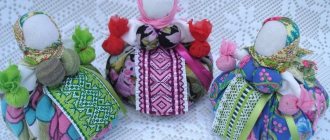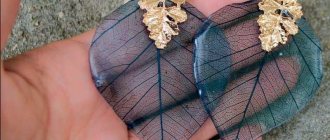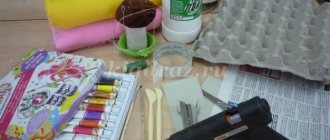Handmade dolls are highly valued not only among lovers of miniature copies of people, but even among professional collectors. The work skillfully executed in the smallest detail fascinates and evokes a feeling of admiration. A human figurine can be made from a variety of materials, both traditional and relatively new ones that have appeared not so long ago. Performance techniques are also varied. The figurine can be sewn, knitted, woven and even sculpted. In this article you will learn how to make a doll from cold porcelain at home.
Before we begin to consider the process of making dolls from cold porcelain, we will consider their main varieties that can be sculpted.
Polymer clay dolls for beginners
If you are already puzzled by the question of how needlewomen make dolls from polymer clay with their own hands, then our review article will help you understand this topic. We do not promise that you will easily master this technique; some products require great perseverance and a lot of time.
However, you can start with simple crafts made from polymer clay; they do not require a lot of material or painstaking work; the basic thing is that you will definitely need an oven with a thermometer.
And so, it will be enough to purchase:
- polymer clay;
- wire (thick and thin);
- foil (preferably soft);
- acrylic paints;
- hair for dolls;
- glue;
- varnish;
- tools - stacks, metal and plastic sticks.
The main thing in creating a craft is to accurately maintain the proportions of the doll’s body. Masters of polymer clay sculpting recommend creating a body in the size of approximately 7–9 toy heads.
Next, a step-by-step master class for creating a doll from polymer clay is as follows:
- Bend a thick wire so that you get a loop on top, cover it with foil, forming a ball, cover the ball with clay - this will be the head.
- Form hands from plastic, cut fingers in the hands so that they are slightly apart. String them on both sides onto the ends of the second piece of wire and attach this part to the existing wire with the head.
- Form the legs in the same way; they should be strung on the ends of the wire of the main workpiece. Twist the wire in the center, mark the waist and stick the chest and neck onto the frame. Evaluate the craft, add material where it is missing.
- Place the product in the oven. We'll talk about baking temperature and time below.
- Using paints, draw eyebrows, freckles, eyes, cheeks, lips. Glue the hair with glue (craftswomen advise pressing strands of hair with a needle, but if the doll is small, then much work will not be required). Dress up the doll.
General description of products
Three countries can be considered the official homeland of BJD: China, Japan and South Korea. It was there that mass production of such dolls first began. Today, the market has successfully expanded to European countries, Russia and America. Over time, domestic products began to be called simply BZD. Even an absolute beginner can make a doll with his own hands. However, to do this you will need to familiarize yourself with the main characteristics of such products listed in the list below.
- All elements are hollow and are pulled together using special connections.
- The occipital part can be easily removed if the need arises. This area is secured using clamps or magnets.
- The most common manufacturing materials include polyurethane, quick-setting plastic or porcelain. The latter is most often used in expensive designer crafts.
- Standard elements like eyes and hair can be easily removed. Several wigs can be supplied with one product. The eyes are made of a plastic material, the properties of which are somewhat similar to those of ordinary plasticine.
Polymer clay doll master class
If you are already familiar with polymer clay and know all its intricacies, then you can try making a doll. But get ready for the fact that such an activity will take a lot of time and effort.
Don't forget to think through all the details, from what color your character's skin will be, to small details on clothing or additional attributes to complete the look.
Preparation for production
Making a doll based on polymer clay is a lengthy process. Sometimes it can take several months to create this sweet masterpiece. Before you make a doll from polymer clay, you need to understand that this is not easy work.
Before you start you need:
- carefully consider the image of the doll;
- choose the type of product (dolls can be static or articulated);
- draw a drawing (exact parameters are indicated on it and details are drawn);
- prepare all the necessary materials for manufacturing based on well-thought-out details.
It is appropriate to say that there are few people who make dolls based on polymer clay. Thanks to hard work, almost every one of them becomes famous. The works of such people can be found in special magazines.
It is impossible to make completely identical dolls; each one differs in small details. It is this nuance that makes the finished products attractive.
Let's move on to a more detailed look at the topic of how to sculpt a doll from polymer clay.
Step-by-step production of a polymer doll
Before sculpting a doll from polymer clay, carefully think through all the details, decide on the color of the skin, the shade of the eyes and even the small components of future clothing. Come up with additional attributes for the perfect image.
All this preliminary preparation will help you get inspired before starting the creative process.
We select materials for work
Before you start manufacturing, prepare a number of necessary materials:
- main material – polymer clay;
- special knives with different designs;
- foil;
- sanding paper;
- pliers;
- hard wire;
- tassels;
- glue;
- dye;
- primer.
You can start preparing material for the clothes of the future doll in advance. Don't forget about your hair. For them it is better to use wool, which is used for felting. In the future, everything will depend on the course of your thoughts and imagination.
When you have all the materials ready, make a choice towards a specific model of the doll.
They can be:
- Articulated. This is the most difficult manufacturing option. It requires experience and more time.
- From several types of materials. This is the simplest type of pupa. In this case, the body is made of fabric, and the head, arms and legs are made of clay.
- Static. There are no complicated elements here and making such a doll is not that difficult.
We will focus on the last variety. Make a drawing of the doll, draw the expected image of the future product. Here you need to pay attention to its size and features. Check if you have all the materials. Let's start work.
Frame making
The frame in the product plays one of the most important roles. Thanks to him, the finished doll will be durable. Before making dolls from polymer clay, prepare a skein of strong wire and a second skein of thin wire.
In the future, work will be carried out in the following order:
- take a thick wire and give it the shape of the “skeleton” of the future doll;
- use thin wire to wrap the “skeleton” to give it density;
- Seal the resulting frame with foil;
- smooth out all the folds, press and compare the result with the drawing.
The frame preparation stage is over. Let's proceed to the basic steps that will tell you how to make a doll from polymer clay.
Head decoration
It's time to start preparing the blank. To ensure that the process does not cause difficulties, the clay must be kneaded well and heated to a plastic state. Perform the following actions based on the instructions:
When the clay becomes plastic, shape the part of the head that is covered with foil. The resulting result should be baked in the microwave or oven. If you used clay that hardens on its own, this is not necessary. It is necessary to bake the material so that in further work it does not lose its shape.
Important! If foil was used and it is not covered with polymer clay, then it cannot be placed in the microwave oven. Is it dangerous! It can only be heated in the oven.
- We take out the blank of our doll. Using a knife, carefully add volume to the head. Select the nose, cheeks and lips. We smooth out the unevenness so that the face becomes realistic and resembles a living one.
- We make recesses for the eyes. Watch for symmetry, so the work will turn out neat.
- We've finished the head work. It can be decorated with pastel or aerosol paints to give the face a lively tint. We send the doll to bake again and finish the ears on the head.
Body sculpting
- We continue to work. Now we will start sculpting the arms and legs. Try to do this work carefully so that there are no unevenness. When the base of the arms and legs is ready, start cutting out the fingers.
- If the small elements are ready, sculpt the torso, back and tummy. If you want to. To give the doll a more sophisticated look, we recommend adding small elements such as collarbones and ribs. But here it’s up to you, each doll is individual. The finished product is sent to bake.
It may take longer to bake than was required when making the head. It is important that the product becomes very durable.
- When the material has completely hardened, you can begin grinding. To make the doll without any roughness, use sandpaper with different grain sizes. While sanding, leave a parting on your head.
Now you know how to make a doll from polymer clay. The work is not finished yet. It's time to start styling your face.
The following materials can be used here:
- pastel;
- acrylic;
- watercolor pencil.
Pencil is the perfect choice if you need to add freckles to your doll.
When you are finished applying makeup, coat the product with varnish. He will record the result.
Hairstyle for a doll
We figured out how to make the base of a doll from polymer clay. Now she definitely needs to get her hair done. It has already been said that for this purpose it is better to use wool for felting.
But you can use:
- silk threads;
- doll wig;
- big wig.
A wig for dolls is not always beneficial, as you can make a mistake with the size. It is better to use a large wig, from which you can make a separate doll hairstyle.
- To attach the hair you will need glue. Separate each strand separately and attach it to the head. To make your work more convenient, you can use an awl, hook or other thin metal object.
Lastly, we insert the finished hair into the previously prepared parting. This will give your doll a neat crown.
The doll is ready, give it the desired hairstyle, decorate it with additional elements and be sure to dress it. The work is long, painstaking, but exciting.
Shape modeling
There comes a time when you need to literally make a BJD doll with your own hands. Modeling is done by mixing sawdust and so-called stoneclay, that is, a special plastic that can harden directly in the air. The result should be a homogeneous mass. The resulting mixture should be applied to the parts of the doll with sawdust and dough. There is also another useful tip. During the work, it is better to make all notes with colored pencils or crayons. The fact is that ink can have a very negative effect on plastic.
The further modeling process can be explained using the example of creating palms with fingers. The base for the brush is cut from stainless steel. The future palm is created from a previously prepared mass with sawdust, and then holes for five fingers are cut out in this part of the body. Thin stainless steel rods are threaded through the previously made holes. For additional strength, the fingers can be secured with epoxy resin, after which they need to be bent according to your own idea.
DIY polymer clay doll
When starting to make a stationary doll, you need to be patient. To work you will need:
- polymer baked clay white or flesh-colored;
- wire for frame;
- working surface - glass or ceramic, smooth;
- soft foil;
- plastic knife or stationery knife;
- scalpel or other sharp cutting object for fine operations;
- dots or stacks (you can get by with needles, knitting needles, toothpicks);
- sanding machine or sandpaper No. 0;
- alcohol-free wet wipes;
- acrylic eyes of the desired size and color;
- a small bunch of goat hair;
- paints.
Drawing and frame
Start with a schematic drawing of a life-size doll. As you sculpt, you will place body parts against it to check the dimensions. All distortions of body proportions must be carefully planned, otherwise the doll will look awkward.
Here are some tips:
- baby dolls or touching cartoon characters have large heads;
- for greater grace, Barbie and models are created with an elongated figure, long legs and neck;
- Foresters, gnomes, and hobbits have short legs with huge feet.
The sketch may have been made by an unskilled hand. The main thing is that its proportions and sizes match those of the future doll.
Static figures require a strong frame - it determines the proportions of the body and holds the entire structure. The basis of large dolls can be large-diameter steel wire; for miniature models, copper wire remains.
Bend and twist the figure - loop-head, torso, arms, legs. Where necessary, the wire can be twisted, but it is better to thicken it with turns of thin wire for strength. Next, increase the volume with foil.
Using your fingers or a tool, give the toy the desired shape, smooth out unnecessary bumps and strong dents.
The clay that will be used to cover the figure should be spread evenly - this will minimize the formation of cracks after baking and the entry of air into the structure. After that, attach the frame to the sketch and correct everything that is necessary.
You shouldn’t smooth the foil too much either. A smooth surface has poor adhesion, the clay will move around and build up poorly, which will make work very difficult.
Making the head
Before you start working with clay, wash your hands and wipe the work surface and tools with a damp, clean cloth. Spray the air around you with a household spray bottle. Everything sticks to plastic - tiny particles that we simply don’t notice sit on its surface and spoil the appearance of the product.
It is difficult to remove or pick them out, so it is better to take care of cleanliness in advance.
- If the clay was stored in the refrigerator, remove it in advance and let it warm up to room temperature naturally. Knead the plastic well - this requires some effort, but this will make it easier to work with, and fewer cracks and internal air bubbles will form.
- Tear off a piece of clay, roll it into a cake, wrap the doll's head, level it and smooth it. Draw a barely noticeable vertical line dividing the face into two halves. Mark the location and insert the doll's eyes.
- Smooth out the joints and place the figure in the semi-baked oven. The oven should be preheated to 90-100 °C, the processing time should be half that indicated on the clay pack. This way the clay will remain pliable enough to be worked with with tools, but will become so dense that a careless touch will not be able to deform the figurine’s head.
When working, keep in mind that doll eyes made of acrylic are not afraid of high temperatures.
Wait for the oven to cool completely, remove the figurine and continue sculpting the doll's face from polymer clay. There are many master classes on making heads, but if you haven’t sculpted people from plasticine or dough before, try doing it yourself for the first time.
So next time you will know what to pay special attention to.
Proceed in the following order:
- Roll into small sausages and place on the cheeks, lips, brow ridges and nose. Smooth the joints with a spatula.
- Using dots, needles and toothpicks, form and draw the nostrils and mouth.
- Make sure that symmetry is maintained and correct any shortcomings.
- Use a needle or scalpel to shape the eyelids. Please note that the top must protrude relative to the bottom.
- The visible part of the eye is a hemisphere. Its most convex part is at the pupil.
- To give a natural doll-like look, use a needle to make an indentation near the inner corners of the eyelids.
- Using different tools, work on detailing the face and giving it the desired expression. This is a long and complex process; if necessary, moisten the clay with water.
- Attach and shape the ears.
- Use dots and wet wipes to smooth out the doll's face.
- Color your lips, cheeks, eyebrows. Keep in mind that when heated, the color of acrylic remains the same, but pastel may change shade. To protect yourself from surprises, paint small pieces of clay and bake them in the oven until ready.
- In the middle of the doll's head, make a parting or hole for attaching hair.
- Send to half bake. After cooling, use plastic to correct all defects, seal cracks and sand.
Creating a body
Form the doll's body from clay cakes and send the figurine to the semi-bake. This way, when creating arms and legs, you can hold on to the body without fear of deforming it. Attach the limbs without feet and hands, and put them in the oven again. The number of half-bakes can be any.
For large dolls, when forming the hands, a frame is made for each finger. For little ones, they sculpt the palm right away.
Using a needle or scalpel, 4 fingers are made, the big one is attached separately. Use a napkin to smooth out any unevenness, and use a toothpick or other sharp object to draw the nails. Attach the brush to the arm, smooth out the joints. Shape and attach the feet in the same way.
Finishing touches
If necessary, touch up and polish the figure. Send to bake, set the temperature and time, following the recommendations indicated on the pack of clay. Let the product cool without opening the oven.
If necessary, cover the cracks with special plastic, and finally smooth out any missed irregularities by sanding.
Using the selected colors, paint the face, neckline, palms and nails. If desired, cover the eyes and lips with a special varnish (nail or decoupage varnish is not always suitable for dolls).
It's hair time. Before gluing the hair, dye the goat hair, apply balm and dry it. Using an awl or other metal object (the wool sticks to toothpicks or wooden skewers), glue the strands to the bottom of the head. Finally, glue the hair to the crown, tucking the ends into the parting.
Clothing and jewelry
Where can I get doll clothes? You can buy it, order it from a dressmaker, or sew it yourself from any old, but not shabby, things. The fabric needs to be washed, starched and ironed, and the finished outfit needs to be sprinkled with water so that it does not bulge.
When choosing a material, it is important to correlate its design with the size of the doll. The same applies to jewelry - huge beads or rhinestones on a miniature doll will look ridiculous.
As a finishing touch, you can highlight the folds and folds of clothing with oil paint or tea leaves.
Food for polymer clay dolls
Bananas
Cut the yellow clay into equal pieces and roll them into balls. Roll them into cones, forming a banana. We stick a little green clay to the very tip and smear the edges. We combine several bananas into a bunch. Cut off the excess and blacken the end of the cut.
Fresh loaf
Take a piece of bread-colored polymer clay and roll it into a ball and then into a sausage. Press the stack of strips. A loaf, carrot or banana is food for dolls that is not at all difficult to make. It is somewhat more difficult to make, for example, cut-away berries.
Strawberry
- Fold white, yellow and red clay tightly and roll into a thin sheet.
- Roll a tight tube lengthwise and form a brick.
- Cut it across and insert thin white plates into the cuts. Cut in half lengthwise and form them into two halves of a berry using polymer clay.
- In the same way, make a plate from three colors (beige, yellow and white), twist it, form a cone and insert it inside the berry. Slice the strawberries into thin slices.
Oranges made of polymer clay
You can make beautiful food for dolls with your own hands if you practice a few simple techniques. For example, an orange can be made using three colors of clay: white, orange and yellow.
- Roll orange sausages, cut them lengthwise, insert yellow clay into the cut and roll again.
- Wrap the sausages in a thin white sheet and flatten them slightly on one side.
- Place 8 sausages together, wrap them again with a white clay plate, and then with an orange one.
- Roll a long orange over the grooved surface, creating a citrus peel effect.
- Cut the orange into slices, drawing a design on them in a stack.
Corn
A slightly different technique is used to make an ear of corn. We form the core from green clay. You can use improvised material. We roll a long rope out of yellow plastic and wind it onto the core in a tight spiral. Draw longitudinal stripes in a stack. Cut out thin green leaves and wrap them around the cob.
Photo ideas
Mug with a doll made of polymer clay
Polymer clay was invented relatively recently. Masters have known about this material for no more than half a century. Today, sculpting with it is a very popular hobby for amateurs and a professional activity for experienced designers.
Buying polymer clay a couple of years ago was very problematic. Residents of various Russian cities ordered it from the capital or from other countries.
Now almost all art salons or craft stores offer such plastic, where it lies next to knitting yarn, dyes and floss that are familiar to us. You can make many interesting crafts from this amazing material.
These are not only souvenirs, but also a huge number of other things that will decorate our lives.
How to make a jointed doll: sequence of work
The main stages of work (each of which takes from several hours to several days) are:
- execution of the sketch;
- making a rough model from plasticine;
- creating molds for casting from clay or plaster (molds);
- pouring plastic into molds and creating parts of the future doll;
- sanding and grinding of parts;
- firing of parts in an oven (some types of injection molded plastic do not require firing);
- assembling the doll (installing hinges and hooks);
- painting of the product;
- final touches (clothing, wig, stand).
